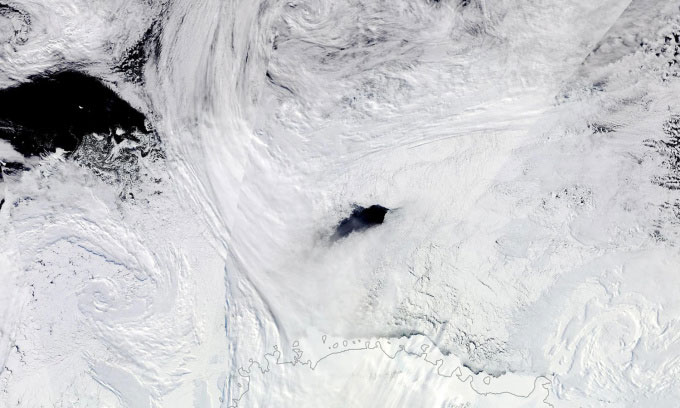The Maud Rise Polynyas: A Scientific Mystery Unraveled
Researchers first discovered the Maud Rise polynya – an area of open water surrounded by sea ice – in the Weddell Sea, Antarctica, in 1974 and 1976. Since then, this polynya has appeared multiple times in the same location, varying in size, but sometimes disappearing for many years. This phenomenon has puzzled scientists, leaving them uncertain about the exact conditions required for its formation.

Maud Rise polynya viewed from above. (Photo: Earth Observatory, NASA)
In 2016 and 2017, the 80,000 km² polynya opened for a few weeks during both winters, providing scientists with an opportunity to study it further and ultimately solve this mystery, as reported by Live Science on May 3. The new research, published in the journal Science Advances, was conducted by postdoctoral researcher Aditya Narayanan from the University of Southampton and his colleagues.
In Antarctica, as the transition from summer to winter occurs, sea ice expands from a minimum area of about 3 million km² to 18 million km², covering 4% of the Earth’s surface. Most sea ice develops during the “polar night” – a phenomenon lasting several weeks – on the floating ice shelves surrounding the continent. Ice holes, known as polynyas, form when strong winds from the continent push ice blocks apart. This frigid wind also freezes additional seawater within the polynyas.
However, in the open waters far from coastal winds, where the Maud Rise polynya appears, the likelihood of polynyas forming is lower. The combination of this issue and the declining ice mass in the Southern Ocean has raised questions among scientists about the factors contributing to the formation of the Maud Rise polynya.
To decode this mystery, Narayanan and his team examined data from satellites, automated buoys, tagged marine animals, and previous observations by other researchers. They found that in 2016 and 2017, the circular ocean current of the Weddell Sea, the Weddell Gyre, was stronger than in other years, allowing underwater flows to more easily bring salt and heat closer to the surface.
The Maud Rise polynya is located near the Maud Rise seamount. In 2016 and 2017, due to the stronger currents, salt was suspended around this seamount while winds blew over the surface, creating a spiral effect that pulled salty water around the seamount to the ocean surface. The salt lowered the freezing point of the surface water, facilitating the formation of the Maud Rise polynya.
The research team stated that this new discovery is crucial for understanding Antarctica and its broader impacts on the global ocean. Climate change is causing winds from this continent to strengthen, which may lead to the formation of more polynyas in the future. Additionally, 40% of the world’s seawater originates from the Antarctic coast, making this region extremely important for regulating the climate of various areas on Earth.


















































